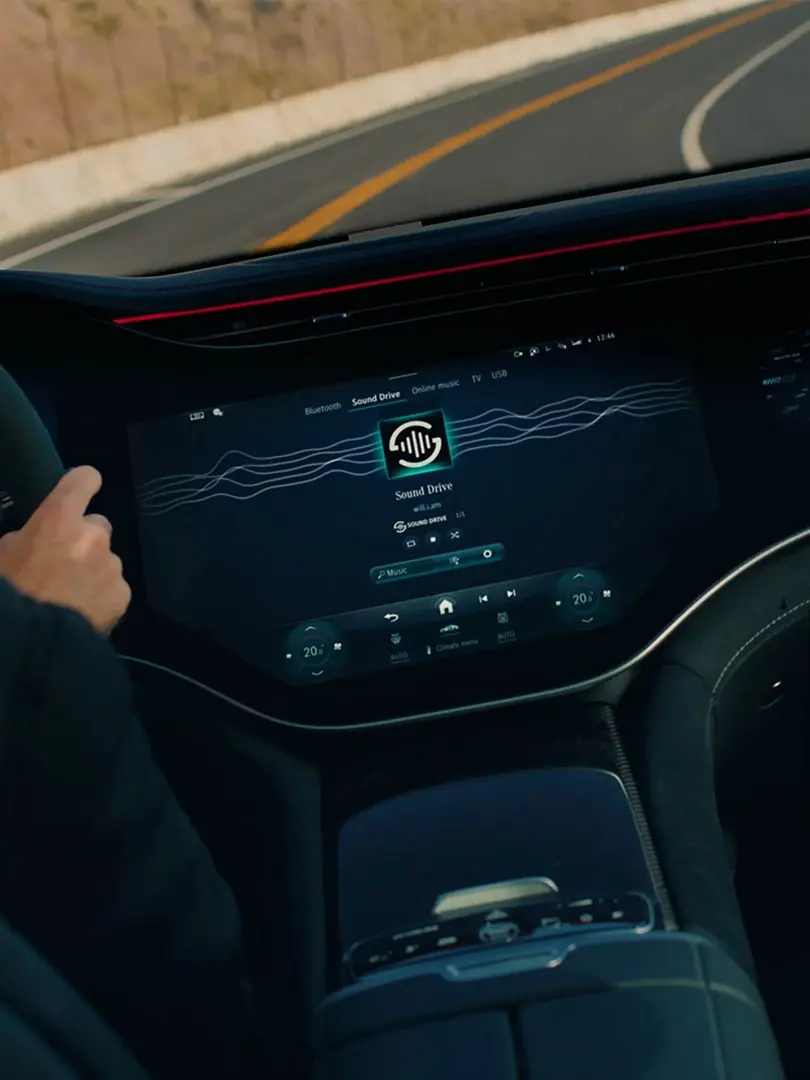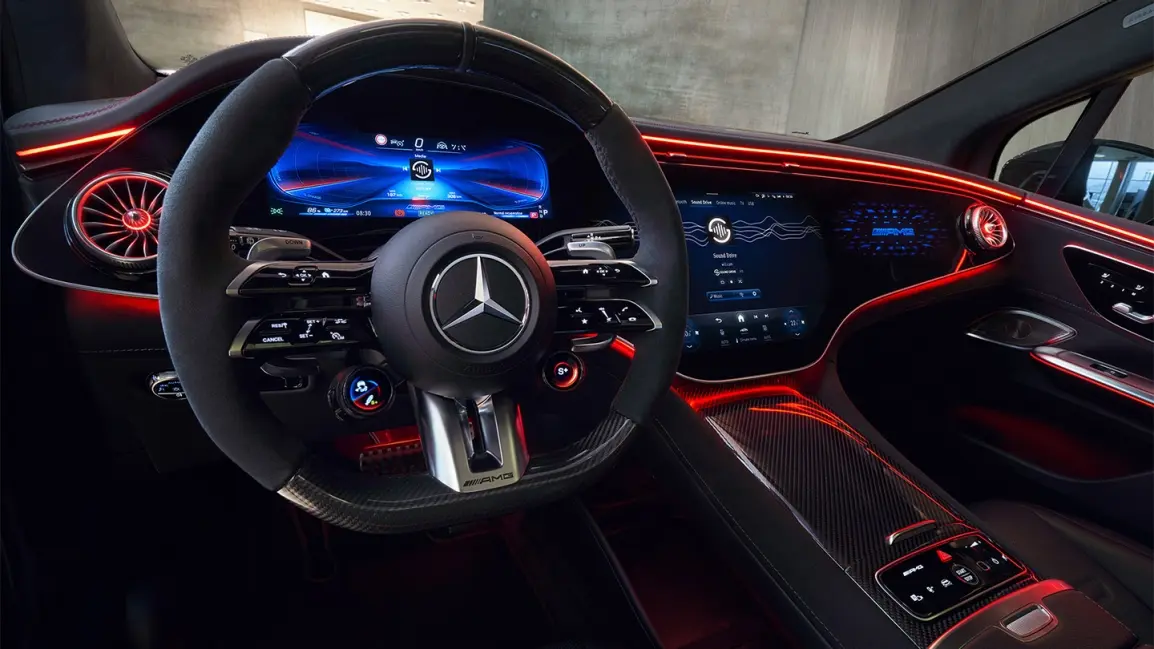Mercedes-AMG brings Interactive Music to the Driving Experience 🚙 🎵
Advertisement:
Mercedes-AMG has always been synonymous with luxury and performance, pushing the boundaries of automotive innovation. Mercedes keeps doing fun experiments with music including a collaboration with Linkin Park: Their latest venture, the MBUX SOUND DRIVE, takes this commitment to new heights by merging cutting-edge technology with immersive audio experiences. Developed in collaboration with global music icon will.i.am, the MBUX SOUND DRIVE is more than just an in-car audio system; it’s an interactive sound experience that responds dynamically to the driving environment, turning each drive into a personalised sonic journey. "With the world first MBUX SOUND DRIVE, the music in your Mercedes-AMG responds to your individual driving style. From piano to fortissimo. Your vehicle practically becomes a virtual musical instrument on the road – and you use it to compose your own music.", as their official blog post quotes. At the heart of the MBUX SOUND DRIVE is the concept of interactive music, where soundscapes are generated in real-time based on various driving inputs. Every acceleration, braking action, and turn influences the audio output, creating a soundtrack that’s unique to each drive. The system is integrated with the vehicle’s MBUX (Mercedes-Benz User Experience) system, utilising sensors that monitor the car’s movements and translate them into musical elements.
This innovation is akin to transforming the vehicle into a musical instrument, where the driver becomes the conductor, orchestrating a symphony of sounds that evolve with the journey. Whether cruising along a scenic route or navigating through urban traffic, the MBUX SOUND DRIVE adapts to create an auditory experience that mirrors the intensity and rhythm of the drive. With such immersive driving experiences, artists could find their work even more present in the lives of their fans. And it's not just the driver, but everyone sitting in the car enjoying the same music – until of course the technology allows directional speakers in cars enabling everyone to listen to their own favourite artists. Irrespective of the music playing, the "change" in it would be based on the movement of the vehicle and will continue to feel fun.
Do humans associate with the timbre/soundscape or is it the melody that stays with us for longer? I guess the latter, but melody is arrangement too and changing it, even in pace / rhythm, could break the flow. I guess Generation Beta will let us know. Here is a live demo: Interactive music has found its home beyond the world of games. While a majority of linear audio creatives are still wondering if they should give game audio a try, some people in the world have mastered the art of interactive storytelling through sounds and built experiences we can all be inspired by. (yes, this paragraph is meant to provoke more people to learn interactive audio: Wwise, FMOD Studio, Max, Pure Data, Unreal Engine MetaSounds – whatever you prefer) Interactive music, while traditionally rooted in video games, is now breaking new ground across various industries, with the automotive sector leading the charge. The MBUX SOUND DRIVE is a prime example of how this technology can enhance user experience in a completely different context. But the potential of interactive music extends far beyond gaming and cars. The meaningfulness of all these use cases, of course, is dependent on how the soundscape is planned and the results are subject to the experiments. Having said that, it's an open area for exploration. It's obvious that when a big name showcases the world of new possibilities, that's when more people who were hesitant until now, would hear the wake up call to finally learn what they have always wanted to – well, better late than never! Creating such advanced interactive music experiences requires a blend of technical expertise, artistic vision, and a deep understanding of human-computer interaction. Aspiring creators in this field should focus on developing a diverse skill set that encompasses the following areas:
1. Programming and Software Development: Tools: Learning platforms such as Max and Pure Data are essential for understanding how to build interactive sound environments. Skills: Proficiency in languages like C++ and Python could help, as is a solid grasp of Digital Signal Processing (DSP). Understanding real-time audio processing and how to manage low-latency environments is key to creating responsive audio experiences. 2. Music Theory and Sound Design:
A strong foundation in music theory is essential, particularly in areas like composition and orchestration. Sound design skills are equally important, as creators need to craft audio elements that can dynamically interact with user inputs. Knowledge of adaptive music composition, where music can change based on specific triggers or conditions, is particularly valuable. 3. Machine Learning and Data Analysis:
Machine learning is increasingly becoming a cornerstone of interactive systems. By learning how to apply machine learning algorithms to analyse and respond to real-time data inputs, creators can develop systems that offer more nuanced and personalised audio experiences. This could involve training models to predict user behaviour or to generate music that adapts to the user’s emotional state. 4. UX/UI Design:
Designing intuitive interfaces that allow users to interact with complex sound systems is a critical skill. This includes understanding user psychology, crafting user-friendly controls, and ensuring that the audio-visual interaction enhances the overall experience rather than detracting from it. 5. Collaborative Tools:
Familiarity with Digital Audio Workstations (DAWs) can help for integrating traditional music production workflows with interactive systems. These tools enable creators to design, produce, and implement adaptive soundscapes efficiently.I have a feeling that they also were collaborating with Linkin Park for their MBUX SOUND DRIVE project but the turn of events probably didn't work out.

"Imagine a world in which your car becomes an instrument that enables musical journeys. MBUX SOUND DRIVE opens up completely new, exciting and interactive listening experiences for drivers."
- will.i.amThe Fusion of Music and Motion:

"With MBUX SOUND DRIVE, the AMG drivers determine how their music sounds. This makes in-car entertainment much more immersive."
- Markus Schäfer, Member of the Board Mercedes-Benz Group AG, Chief Technology OfficerArtists x Fan Connections:
Ever heard a song and got reminded of that train ride you took a long time ago? That's how music has helped us associate life moments, subconsciously. And this is how artists connect with their audience beyond the usual music performance.
But the question has to be asked: is a continuously changing musical arrangement as connecting as a fixed one? Just like advertisements, we tend to remember each and every pause and rise in our favourite songs because of the fact that they repeat in the same exact arrangement every time. Would breaking this structure still manage to find its place in our memories?
Interactive Music beyond Gaming:
 1. Wellness and Health:
Interactive music systems could be integrated into wellness apps and devices to help users manage stress, meditate, or even enhance physical therapy sessions. By responding to biometric data such as heart rate or brainwaves, music could adapt in real-time to soothe or energise users, providing personalised therapeutic experiences.
2. Education:
In educational settings, interactive music can create engaging learning environments. For instance, in language learning apps, the pace and tone of background music could change based on a student’s progress or engagement level, making the learning process more immersive and responsive.
3. Entertainment:
Beyond video games, interactive music can redefine how we experience movies or virtual reality (VR) content. Imagine watching a film where the soundtrack adjusts to your reactions or immersing yourself in a VR world where the soundscape evolves as you explore, creating a fully immersive experience that’s unique to each viewer.
1. Wellness and Health:
Interactive music systems could be integrated into wellness apps and devices to help users manage stress, meditate, or even enhance physical therapy sessions. By responding to biometric data such as heart rate or brainwaves, music could adapt in real-time to soothe or energise users, providing personalised therapeutic experiences.
2. Education:
In educational settings, interactive music can create engaging learning environments. For instance, in language learning apps, the pace and tone of background music could change based on a student’s progress or engagement level, making the learning process more immersive and responsive.
3. Entertainment:
Beyond video games, interactive music can redefine how we experience movies or virtual reality (VR) content. Imagine watching a film where the soundtrack adjusts to your reactions or immersing yourself in a VR world where the soundscape evolves as you explore, creating a fully immersive experience that’s unique to each viewer.Learn & Build Experiences – Skills, Tools, and Programs for Aspiring Creators:
Syntorial by Audible Genius is superb when it comes to learning synthesis, which is at the core of being able to delve into procedural audio.
I feel this is just the beginning. With more people trying out this feature in Mercedes Benz, we'll get more insights into what works and what doesn't.
It would be interesting how this sounds on Indian roads. It's also important to note how this influences road safety.
What do you think about this format of an existing technology finding use case in an industry it was not initially planned for? Let me know in the comments, and share this article with anyone who would find this interesting.
Credits: Images used in this article are taken from this page: https://www.mercedes-amg.com/en/home/stories/mercedes-amg-mbux-sound-drive.html
Written by Prashant Mishra
Audio Developer Conference (ADC) | Universal Category System (UCS) | Game Audio India | National Institute of Design | Music Hack Day India | Music Tech Community | Previously collaborated with & contributed to School of Video Game Audio | Disney Publishing Worldwide (DPW) | ISMIR | Osmo | Airwiggles | epic! and more
